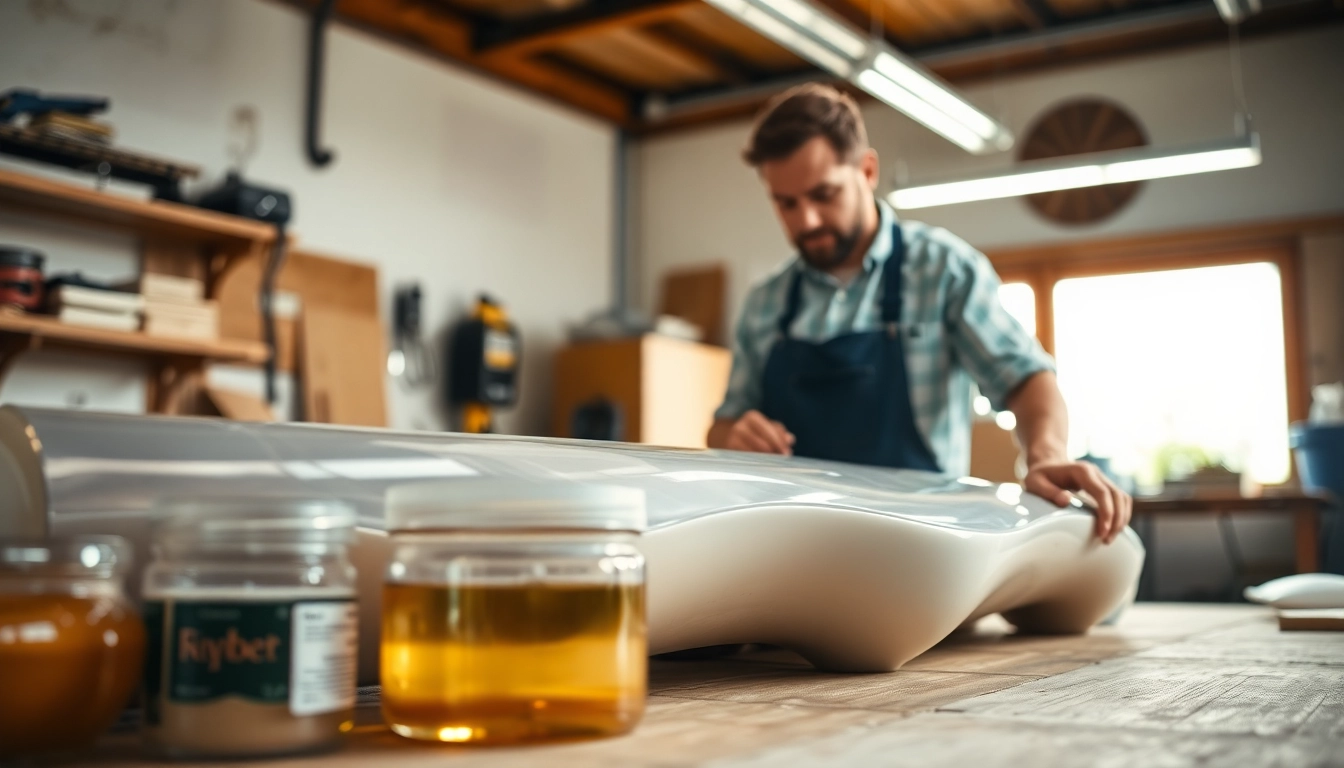Understanding Laminating Resin
What is Laminating Resin?
Laminating resin is a type of polymer material primarily used in the construction and manufacturing of composite products. It acts as an adhesive, bonding layers of material (often fiberglass or composite fabrics) together to create a robust, durable structure. When cured, laminating resin forms a solid, rigid layer that enhances the underlying material’s strength and resilience against environmental stressors.
This resin can be formulated with various chemical properties, enabling its use in a multitude of applications across diverse industries. Understanding laminating resin is crucial for professionals engaged in composite manufacturing, boat building, automotive production, and many available applications, including sports equipment and construction materials. To explore the various types and benefits of laminating resin, visit this comprehensive resource on laminating resin.
Types of Laminating Resin
Laminating resins primarily fall into three categories: polyester, epoxy, and vinyl ester. Each type has distinct properties and is suited for different applications.
- Polyester Laminating Resin: This is the most commonly used resin in the composite industry. It is cost-effective and easy to work with, making it ideal for various applications, particularly in marine construction. Polyester resin is typically used in situations where the highest level of performance isn’t mandatory but where a solid, functional bond is needed.
- Epoxy Laminating Resin: Known for its superior mechanical properties and chemical resistance, epoxy resin is preferred in high-performance applications. It is often more expensive but provides exceptional adhesion, durability, and flexibility, making it suitable for aerospace and high-end marine applications.
- Vinyl Ester Laminating Resin: This is a hybrid between polyester and epoxy resins. Vinyl ester is known for its excellent resistance to heat and corrosion, making it ideal for applications such as the construction of chemical tanks or in environments requiring higher temperatures.
Properties and Characteristics
The properties of laminating resin greatly influence its performance and suitability for specific applications. Key characteristics include:
- Curing Time: Different formulations of laminating resin cure at different rates. Polyester resins generally cure faster than epoxy resins, which can be advantageous in high-volume production settings.
- Viscosity: The viscosity of laminating resin impacts how easily it can be applied. Lower viscosity resins can wet out fabrics more efficiently, while higher viscosity resins may provide more gap-filling properties.
- Mechanical Strength: Epoxy resins typically exhibit superior mechanical strength compared to polyester. This property is crucial for applications requiring structural integrity.
- UV Resistance: Some laminating resins come with added UV stabilizers to mitigate the effects of sunlight exposure, making them ideal for outdoor applications.
Applications of Laminating Resin
Industries that Use Laminating Resin
Laminating resin is utilized in various industries, including but not limited to:
- Marine Industry: Laminating resin is extensively used in boat manufacturing, where it bonds fiberglass layers to create boat hulls and other structures.
- Aerospace: In the aerospace sector, laminating resin is used in the creation of lightweight yet strong components for aircraft.
- Automotive: Laminating resin strengthens components in vehicles, contributing to weight reduction and improved fuel efficiency.
- Construction: Laminating resin plays a role in the construction of composite panels, beams, and other structural elements that require enhanced strength.
Specific Use Cases
Within these industries, several specific use cases highlight the versatility of laminating resin:
- Boat Hull Construction: The marine industry heavily relies on polyester laminating resin for constructing boat hulls that require durability and buoyancy.
- Wind Turbine Blades: Epoxy laminating resins are commonly used to manufacture wind turbine blades, ensuring they can withstand extreme weather conditions.
- Sports Equipment: High-performance sports equipment, such as racing bicycles and surfboards, often incorporates laminating resin for lightweight yet resilient structures.
Benefits of Using Laminating Resin
The advantages of utilizing laminating resin are numerous:
- Enhanced Strength: Laminating resin significantly increases the strength of composite materials, making them suitable for demanding applications.
- Lightweight Structures: Laminating resin enables the production of lightweight structures without compromising performance, which is critical in aerospace and automotive applications.
- Cost-Effectiveness: Especially in the case of polyester laminating resin, the materials are often more affordable than traditional metals or other construction materials.
Choosing the Right Laminating Resin
Different Formulations
Choosing the appropriate laminating resin formulation requires an understanding of the intended application. Factors such as operating environment, mechanical strength requirements, and curing times all influence the decision-making process.
Factors to Consider
When selecting a laminating resin, consider the following factors:
- Application Environment: Determine whether the application will be exposed to chemicals, moisture, or extreme temperatures, as certain resins offer better resistance than others.
- Mechanical Properties: Assess the required tensile strength, impact resistance, and flexibility of the end product to select a resin that meets these criteria.
- Processing Conditions: Evaluate the conditions under which the resin will be processed, including temperature, humidity, and the need for specific tools or machinery.
Comparing Laminating Resin Options
When weighing laminating resin options, it is essential to compare properties such as curing time, viscosity, and post-cure strength metrics. Resins should be evaluated based on their performance in similar applications and the specific needs of the project. References to similar case studies in the industry can serve as valuable guides in making your choice.
Best Practices for Using Laminating Resin
Preparation and Setup
Effective use of laminating resin begins with proper preparation. Here are some best practices:
- Workspace Preparation: Ensure that the workspace is clean and free from contaminants that may interfere with the resin’s adhesion.
- Material Selection: Choose the right type of fabric or material that will optimally interact with the selected resin type.
- Safety Gear: Always employ the necessary safety equipment, such as gloves and masks, to protect against exposure to resins, which can be harmful.
Application Techniques
Applying laminating resin effectively also involves several techniques:
- Layering: Apply the resin in layers, allowing it to saturate the fabric thoroughly for optimal bonding.
- Wet-out Process: Focus on achieving a complete wet-out to eliminate air bubbles and ensure strong adhesion throughout the composite.
- Temperature Control: Monitor ambient temperatures and ensure they are within the optimal range for the resin chosen to ensure proper curing.
Curing and Finishing
After application, proper curing and finishing processes are critical:
- Monitor Curing Time: Follow manufacturer-recommended curing times closely to achieve the desired strength and performance.
- Post-Curing: Some resins benefit from additional post-curing steps, increasing their mechanical properties.
- Finishing Techniques: Smoothing and sanding the surface may be necessary once cured to achieve the desired aesthetic and functional finish.
Troubleshooting Laminating Resin Issues
Common Problems and Solutions
Despite careful preparation, issues may arise during the use of laminating resin. Here are some common problems and suggested solutions:
- Incomplete Curing: If the resin remains tacky after the cure time, consider increasing the temperature slightly to aid in the curing process.
- Bubbles or Voids: To prevent air bubbles, ensure proper wet-out during application and consider applying vacuum bagging during the curing stage.
- Surface Imperfections: If the final finish is rough or flawed, sanding with progressively finer grades of paper may help smooth imperfections effectively.
When to Seek Professional Help
If persistent issues arise or if a critical application demands expert handling, seeking professional assistance can be beneficial. Professionals can provide insight into advanced techniques, troubleshooting strategies, and applications tailored to specific needs.
Future Trends in Laminating Resin Technology
The future of laminating resin technology is promising, with ongoing advancements focusing on sustainability and performance. Innovations may include:
- Bio-based Resins: The development of eco-friendly laminating resins derived from renewable resources may reduce the environmental impact of composite manufacturing.
- Advanced Formulations: Enhanced formulations will likely focus on greater heat resistance, mechanical strength, and faster curing times.
- Smart Resins: Future resins may integrate smart technologies for real-time performance monitoring and adjustments during fabrication.


